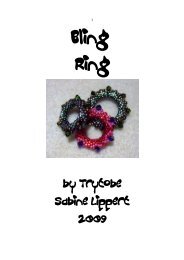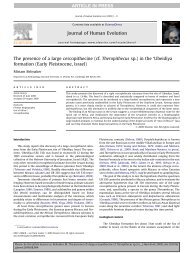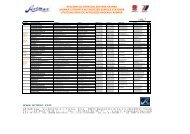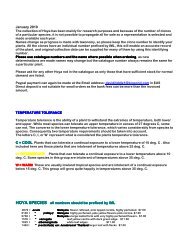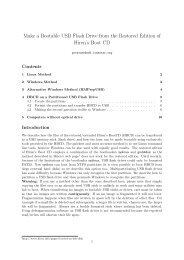A Step Attenuator You Can Build
A Step Attenuator You Can Build
A Step Attenuator You Can Build
Create successful ePaper yourself
Turn your PDF publications into a flip-book with our unique Google optimized e-Paper software.
Fig. 1 - Schematic diagram of the attenuator. Resistors are 114.W, 5%-tolerance, carboncomposition or film types. Resistances am given in ohms.<br />
Table 1<br />
PI Network Attenustor Rerlrtance Values<br />
for 62 Ohm Impedance<br />
Calculated Value Standard Value Used<br />
dB R1, R3 R2 Rl. R3 R2<br />
1 904 8 910 6.2<br />
2 453 12 470 12<br />
1: ~ ~. -<br />
r-<br />
...<br />
TOP ,."-i~<br />
y- .- 3 - an,.<br />
",<br />
SlDEL<br />
i l REQUIRED) 1<br />
- Fig. 2 -- Mechantcal dimensions of the attenuator enclosure.<br />
box edges. Buff the copper with steel<br />
wool, add lettering, and finish off the<br />
work with a coat of clear lacquer or<br />
polyurethane varnish.<br />
Using a little lacquer thinner or acetone<br />
(and a lot of caution), soak the switches to<br />
remove the grease that was put in during<br />
their manufacture. When dry, spray the<br />
inside of the switches lightly with a TV-<br />
tuner cleaner/lubricant. IJsing a sharp<br />
drill bit (about 3/16 inch will do).'<br />
countersink the mounting holes on the ac-<br />
tuator side of the switch mounting plate.<br />
This ensures that the switches will fit flush<br />
against the top plate. At one end of each<br />
switch, bend the two lugs over and solder<br />
them together. Cut off the upper halves of<br />
the remaining switch lugs. (A look at Fig.<br />
3 will help clarify these steps.)<br />
Solder the horizontal members of the pi<br />
12 UST.<br />
sections between the appropriate switch<br />
lugs. Try to keep the lead lengths as short<br />
as possible, and do not overheat the<br />
resistors. Now solder the switches in place<br />
to the top section of the enclosure by<br />
tlowing solder through the mounting<br />
holes and onto the circuit-board material.<br />
Be certain that you place the switches in<br />
their proper positions; correlate the<br />
resistor values with the degree of attenua-<br />
tion. Otherwise, you may wind up with<br />
the l-dB step at the wrong end of the box<br />
- how embarrassing!<br />
Once the switches are installed, thread a<br />
piece of no. 18 bare copper wire through<br />
the center lugs of aU the switches. passing<br />
it through the holes in the partitions.<br />
Solder the wire at each switch terminal.<br />
Cut the wire between the poles of each in-<br />
dividual switch, leaving the wire con- 'ig. 3 - Ciose.up of the switch detail



